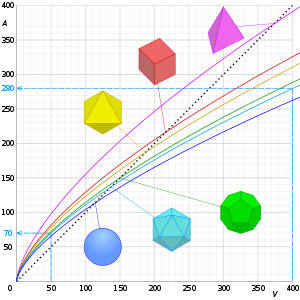
Back Relació àrea-volum Catalan A/V-Verhältnis German Relación superficie-volumen Spanish Azalera eta bolumenaren arteko erlazioa Basque نسبت سطح به حجم Persian Rapport aire-volume French Relación área superficial-volume Galician Rasio luas permukaan terhadap volume ID Jumlah luas permukaan per isi padu Malay Surface-area-to-volume ratio SIMPLE

The surface-area-to-volume ratio or surface-to-volume ratio (denoted as SA:V, SA/V, or sa/vol) is the ratio between surface area and volume of an object or collection of objects.
SA:V is an important concept in science and engineering. It is used to explain the relation between structure and function in processes occurring through the surface and the volume. Good examples for such processes are processes governed by the heat equation,[1] that is, diffusion and heat transfer by thermal conduction.[2] SA:V is used to explain the diffusion of small molecules, like oxygen and carbon dioxide between air, blood and cells,[3] water loss by animals,[4] bacterial morphogenesis,[5] organism's thermoregulation,[6] design of artificial bone tissue,[7] artificial lungs [8] and many more biological and biotechnological structures. For more examples see Glazier.[9]
The relation between SA:V and diffusion or heat conduction rate is explained from flux and surface perspective, focusing on the surface of a body as the place where diffusion, or heat conduction, takes place, i.e., the larger the SA:V there is more surface area per unit volume through which material can diffuse, therefore, the diffusion or heat conduction, will be faster. Similar explanation appears in the literature: "Small size implies a large ratio of surface area to volume, thereby helping to maximize the uptake of nutrients across the plasma membrane",[10] and elsewhere.[9][11][12]
For a given volume, the object with the smallest surface area (and therefore with the smallest SA:V) is a ball, a consequence of the isoperimetric inequality in 3 dimensions. By contrast, objects with acute-angled spikes will have very large surface area for a given volume.
- ^ Planinšič, Gorazd; Vollmer, Michael (February 20, 2008). "The surface-to-volume ratio in thermal physics: from cheese cube physics to animal metabolism". European Journal of Physics. 29 (2): 369–384. Bibcode:2008EJPh...29..369P. doi:10.1088/0143-0807/29/2/017. S2CID 55488270. Retrieved 9 July 2021.
- ^ Planinšič, Gorazd (2008). "The surface-to-volume ratio in thermal physics: from cheese cube physics to animal metabolism". European Journal of Physics European Physical Society, Find Out More. 29 (2): 369–384. Bibcode:2008EJPh...29..369P. doi:10.1088/0143-0807/29/2/017. S2CID 55488270.
- ^ Williams, Peter; Warwick, Roger; Dyson, Mary; Bannister, Lawrence H. (2005). Gray's Anatomy (39 ed.). Churchill Livingstone. pp. 1278–1282.
- ^ Jeremy M., Howard; Hannah-Beth, Griffis; Westendorf, Rachel; Williams, Jason B. (2019). "The influence of size and abiotic factors on cutaneous water loss". Advances in Physiology Education. 44 (3): 387–393. doi:10.1152/advan.00152.2019. PMID 32628526.
- ^ Harris, Leigh K.; Theriot, Julie A. (2018). "Surface Area to Volume Ratio: A Natural Variable for Bacterial Morphogenesis". Trends in Microbiology. 26 (10): 815–832. doi:10.1016/j.tim.2018.04.008. PMC 6150810. PMID 29843923.
- ^ Louw, Gideon N. (1993). Physiological Animal Ecology. Longman Pub Group.
- ^ Nguyen, Thanh Danh; Olufemi E., Kadri; Vassilios I., Sikavitsas; Voronov, Roman S. (2019). "Scaffolds with a High Surface Area-to-Volume Ratio and Cultured Under Fast Flow Perfusion Result in Optimal O2 Delivery to the Cells in Artificial Bone Tissues". Applied Sciences. 9 (11): 2381. doi:10.3390/app9112381.
- ^ J. K, Lee; H. H., Kung; L. F., Mockros (2008). "Microchannel Technologies for Artificial Lungs: (1) Theory". ASAIO Journal. 54 (4): 372–382. doi:10.1097/MAT.0b013e31817ed9e1. PMID 18645354. S2CID 19505655.
- ^ a b Glazier, Douglas S. (2010). "A unifying explanation for diverse metabolic scaling in animals and plants". Biological Reviews. 85 (1): 111–138. doi:10.1111/j.1469-185X.2009.00095.x. PMID 19895606. S2CID 28572410.
- ^ Alberts, Bruce (2002). "The Diversity of Genomes and the Tree of Life". Molecular Biology of the Cell, 4th edition. New York: Garland Science. ISBN 0-8153-3218-1. ISBN 0-8153-4072-9.
- ^ Adam, John (2020-01-01). "What's Your Sphericity Index? Rationalizing Surface Area and Volume". Virginia Mathematics Teacher. 46 (2).
- ^ Okie, Jordan G. (March 2013). "General models for the spectra of surface area scaling strategies of cells and organisms: fractality, geometric dissimilitude, and internalization". The American Naturalist. 181 (3): 421–439. doi:10.1086/669150. ISSN 1537-5323. PMID 23448890. S2CID 23434720.
© MMXXIII Rich X Search. We shall prevail. All rights reserved. Rich X Search